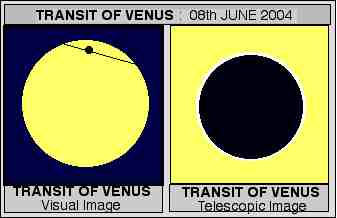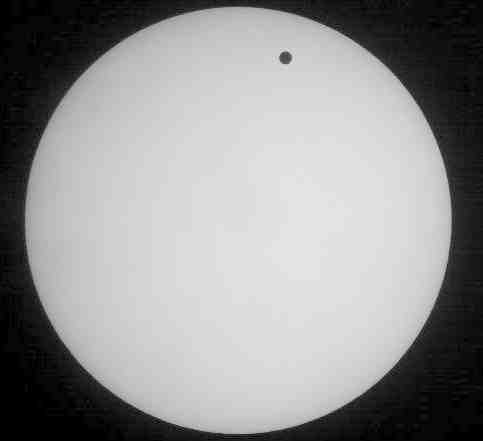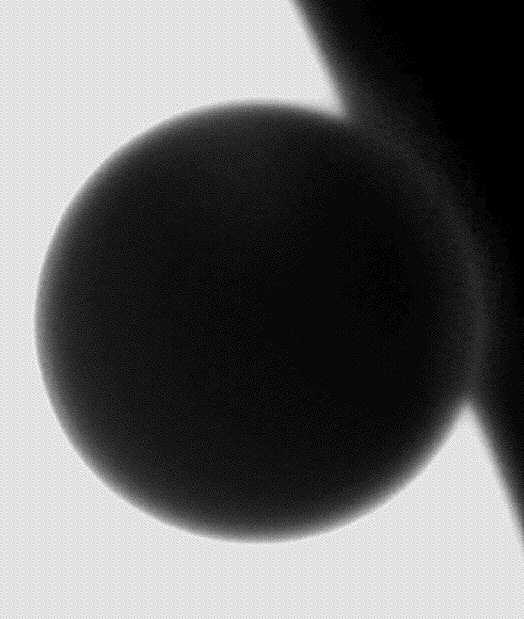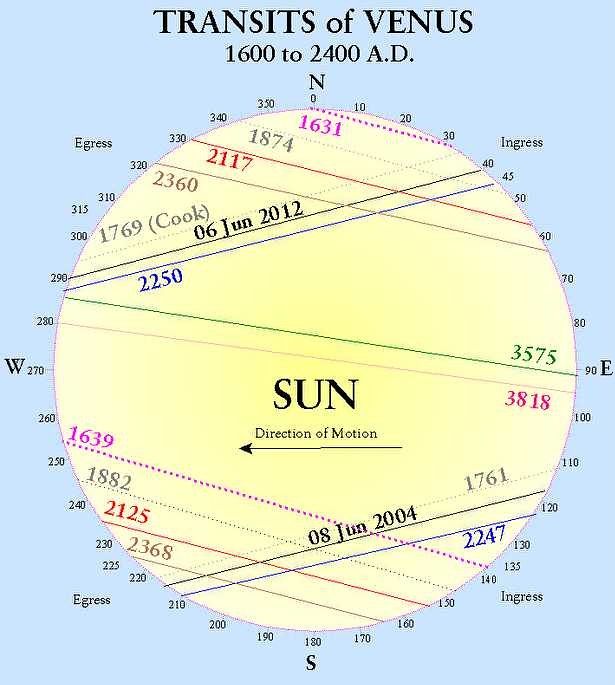I N T R O D U C T I O NHistorically, one of the most eagerly anticipated and rare astronomical events for visual observers is the so-called Transit of Venus where the planet is seen to cross the solar disk during inferior conjunction. Only the planets of Mercury and Venus can do this, by passing in our line-of-sight between the Earth and Sun. Transits are far rarer events compared to the relatively more common solar or lunar eclipses. Once every century Mercury may cross the Sun either thirteen or fourteen times, but for the planet Venus these occur in twice in pairs approximately 115 years apart; and being 121.5 years between each successive series. Geometry of the transit is fairly easy for us to understand. Firstly, Mercury has more transit events than Venus. This is due to the orbital period being 2½ times longer, or more exactly, 224.701 days for Venus compared to 87.969 days for Mercury. If it were not for the orbital inclination or tilt of 3.39° to the ecliptic, then transits of Venus would be more frequent and occur once every planetary orbit. This known fact means that all transits visible from Earth must have the intersection of the orbital plane to the ecliptic almost perfectly aligned with the position of Earth in space. This necessary geometric alignment only allows this to happen either in December or June, when either the orbital descending node (☋) or ascending node (☊) intersects with the geocentric solar position. It should be noted that both these times are about almost exactly six months apart. Since telescopic observations began, only eight events could have been seen. These occurred in pairs in the years 1631 and 1639 AD; 1761 and 1769 AD; 1874 and 1882 AD; 2004 and 2012 AD. Between each mutual series of transits, the months in which they happen is reversed. Hence the 1874 and 1882 events were in December, of those respective years, but the events in 2004 and 2012 were the reverse of this, with both occurring in June. The TRANSITS of 1629 and 1631First astronomer to venture predictions of this remarkable phenomenon was Johann Kepler (1571-1630) in December 1629. He published an appropriate “celestial notice” that announced that Mercury and Venus, were going to make solar transits on two specified days during the northern winter in December 1631. The first ever observed solar planetary transit was by Mercury by the renown French Natural Philosopher, Pierre Gassendi (1592-1655). Yet the first predicted transit of Venus also took place just one month later, but it was later shown though that the general circumstances made the phenomenon impossible to be observed from anywhere in Europe. Sadly, the first of these transit pairs was never properly observed nor recorded. The TRANSIT of 1761For the next transit pair in 1761 and 1769 were very much anticipated. It was Edmund Halley (1656-1742) who figured out a new method to calculate the true distance between Earth and Sun, which importantly, could also be used to determine the true dimensional scale of our Solar System. Calculations relied on several parameters that were quite poorly known at the time. By knowing both the velocity of Venus during the transit and the exact moments of the two contact events of the solar disk with Venus, the length of the astronomical unit (A.U.) could calculated. As such, this created serious need for suitable scientific observations of the phenomena was stated and first drafted in England. Calculations at the time had showed that the entire first event could be seen throughout Europe and towards the east to India. The second transit could only be completed if observed somewhere in the unexplored regions of the South Pacific Ocean. Implications for these observations held much importance to astronomers at the time. Several significant expeditions of great expense were quickly organised — especially with one expedition to observe the second of these series of transits on the other side of the world. During the transit of 7th June 1761, many useful observations were made from the European observatories. These were aided by six major expeditions attempted. For Halley’ s method to work, the results required some distance between locations, and for the transit ingress and egress to be observed with very accurate timings. The British Government then approved and funded three main expeditions. One was placed on the island of St. Helena in the mid-Atlantic Ocean, that was lead by one of their most capable astronomers, Nevil Maskelyne. Another was made at the Cape of Good Hope in now South Africa, by Charles Mason and Jeremiah Dixon. Another site was established in North America in Newfoundland, observed by Professor John Winthorp of Harvard University. Even the French government mounted three expeditions, but these journeys were attempted from far more difficult sites. Travelling across land, Jean Cappe-Baptiste d’Auteroche (1722-1769) observed during mid-winter from Tobolsk. Siberia. Less known, but just as adventurous, was the observation Indian Ocean expedition lead by Alexandre-Gut Pingré at Rodriguez Island, being just east of Madagascar. A third expedition was at the French Colony of Pondicherry in India. This was lead by Guillaume Le Gentil, whose had his observations thwarted, when he was prevented from landing on the foreshore by the British, who happened to be at war with the French. Of all the expeditions, it was Jean Chappe d’Auteroche who proved to be the most successful. Most of the other astronomers had real problems with the cloudy cover, poor weather or determining the exact contact moments when Venus meet the solar limb. Many of the observations that were made were not reduced until much later, when the astronomers could compare and reduce all the observations together. One incidental advantage of these scientific expeditions was to help other unrelated science disciplines, such as geography, geology and botany, from other unexplored locations. The TRANSIT of 1769Eight years later, in 1769, the transit of Venus was considered of even greater importance. Although expeditions throughout the world in the 1761 transit gain results, it was realised that the obtained values were far too diverse to be used for a definitive solar parallax. I.e. 9.44±0.58arcsec (8.28 arcsec to 10.60 arcsec.) and some 7.4% too large. Considering that Halley predicted that the transit could be predicted to 0.015 arcsec, the number of expeditions doubled. The most ambitious was from the South Pacific Island of Tahiti, with an additional off-shoot being several voyages to explore the places and oceans lying in unknown parts of the southern hemisphere. It fell on the famed explorer Lieutenant James Cook (1728-1779), later Captain, to do the observations from Tahiti. This was achieved under trying conditions by the expedition’s astronomer of the voyage, Charles Green (1735-1771). Lieutenant Cook later went on to his European discovery of New Zealand and the east coast of Australia early in the next year. For this reason, the Transit of Venus holds special interest for both Australians and New Zealanders. The SOLAR PARALLAXIn the end, the application of all the classical Venus transit observations proved to be rather inaccurate than expected, but were sufficient enough to produce a rough measure of the estimated distance between Sun and the Earth to what now is called the Astronomical Unit (A.U.). In regard of Venus, the distance being measured is the so-called solar parallax, which represents the apparent diameter of the Earth if it were placed at the very centre of the Sun exactly 1.000 AU away. This theoretical value is about 8.794 arcsec, defining the true scale of the Solar System. Today, the need for transit observations for the 2004 and 2012 events is little more than some celestial-oddity as the solar parallax can be achieved by other means. In the early 1960s the application of radio-waves via radar was used to determine the exact distance of Venus at any instance. In more recent years, sensitivity of radio equipment we can use both Mercury and the Sun itself to determine the distance from Earth to the Sun. The problem of the solar parallax has been on-going since the attempt made by the ancient astronomers like Aristarchus who measured and calculated the value around 3 arcmin. This continued to be adopted until the time of Tycho Brahé. It was Johann Kepler, using Tycho’s observations, who determined the value of around 1 arcmin. By 1630, Vendelinus telescopic observations using the Aristarchus method found about 15 arcsec by measuring the time of the quarter-phased moon. This was about one-twelfth of what Aristarchus had found and about twice the present accepted value. Other methods were applied other than Venus. One of the most significant was by observation from Paris by Cassini of Mars. Using the observed parallax of Mars against the background sky, he calculated the value should be less than 10 arcsec, and assumed in his calculations the value of 9.5 arcsec. This is close to the modern values. However, looking at Cassini’s data the error in an specific value was really about 50%. The most significant development after Cassini was Edmond Halley. Although famous for his discoverer of the 76-year periodic nature of Halley’s Comet, his second achievement could arguably be his work on methods to determine the solar parallax. This time he suggested something experimentally different than the earlier lunar or solar parallaxes, oppositions of Mars and estimated of Venus’ solar conjunctions. Halley travelled to the island of St. Helena to observe the transit of Mercury. TRANSITS of VENUS SINCE the
|
|||||||||||||||||||||||||||||||||||||||||||||||||||||||||||||||||||||||||||||||||||||||||||||||||||||||||||
 |
Figure 1. View of the Transit of
Venus : 8th June 2004 |
Observations on the 8th June 2004 transit from Australia was only seen in part, where on other side of the world throughout in the America’s, Africa and Europe, was seen in its entirety. The Transit of Venus of 2004 was visible from eastern Canada and the U.S.A. Venus during the event subtended 61 arc-seconds, and was visible to the naked-eye using suitable dark filtration. It was the first transit of Venus in 121 years and was most eagerly anticipated.
From Sydney, the skies were fairly clear but the Sun was very close to the north-western horizon. Most anticipated of all the observations was seeing the appearance of Venus disk on the solar limb. After hearing about the event for so many years the transit was thrilling. More interesting was seeing Venus slowly crawl across the solar disk — whose crossing clearly reminded me that the Solar System is not just a static fixture, and that planetary bodies were real moving objects in a real dynamical system. This was real-time evidence that the planets travel with significant velocities.

|
Figure 2. B/W Photo of Venus
During Mid-Transit : 8th June 2004
|
The transit event discerns the jet black disk of the planet and was clearly seen to the naked-eye. This appeared at the very top of the Sun’ disk, whose dimensions can be seen in Figure 2. Poor atmospheric seeing did play havoc with the image on occasions, but for the most part proved inconsequential. The greyish aureole of Venus’ atmosphere was seen even in the 50mmm refractor and binoculars — though not visible to the naked-eye. As the Sun approached the north-western horizon, hanging I suppose by about 5°, the disk merged with the usual thick haze of city, turning into a yellowish-orange ball with the visible spot on the top of the Sun. For a few moments I was able to glance at the Sun and see completely unaided the planet Venus. This last sight is likely the most memorable off all and is something I’ll have trouble forgetting.
However, much of the observed phenomena seen in the last transit in the “pre-modern era” during the 1874 and 1888 certainly failed to live up to expectations. For example, much of the presupposed phenomena as reputed by Henry Chamberlain Russell in 1874, was not seen at all. We can only assume that Russell and others had either imagined or conjectured their observations. This was especially regarding the interactions of the Venusian atmosphere with the the edge of the solar disk and its limb.
OBSERVATIONS of INGRESS and EGRESS
 |
|
Figure 3. |
An initial transit ingress was seen from most of Australia and New Zealand, while the egress was unfortunately to remain invisible. (I have added the information below just for completeness.)
From Sydney, the whole ingress took 19m 16.7 seconds or 1156.7 seconds. Although this figure did vary slightly from place to place, but for most purposes, the timing differences were insignificant. In some ways it is best not to know, because this might interfere the visual observation program of sorts. Few, however, timed the event. Features of the 2004 transit after the end of ingress were continuing for some to be seen perhaps as long as 30 minutes after this time. For most observers, with the Sun fairly high in elevation, saw the vestiges of the ‘black-drop’ for perhaps a few minutes, but really nothing after this. (Observers found this the biggest disappointment of the whole event.)
The movement of the disk proved to be less interesting than initially thought. All that was seen was the black disk with a hazy background slowly moving across the Sun.
Egress on the other hand was not seen except in Europe and Africa, but I did see this live on the Internet from there. Based on the geocentric data, the motion going out is 18.9% shorter, at 15min 56.7 min (956.7 seconds).
TRANSIT of VENUS : 2012
The second of the recent Venus transits occurred on 6th June 2012 and was visible in many portions of the world that missed the 2004 event. From places like Australia and South-East Asia, observers saw the whole Transit.
PAST VIEW on TRANSIT of VENUS : 2004/2012
Richard A. Proctor (1882) makes an interesting prophetic comment on the 2012 Transit of Venus. He reflectively says;
“We cannot doubt that when the transits of 2004 and 2012 are approaching, astronomers will look back with interest on the operations conducted during the present ‘transit-season’ and although in those times; in all probability the determination of the sun’s distance by other methods by studying the moon’s motions, by measuring the flight of light, by estimating the planets’ weight from their mutual perturbations, and so on, will far surpass in accuracy those now obtained by such methods, yet we may reasonably believe that great weight will even then be attached to the determinations obtained during the transits of the present century. The astronomers of the first years of the twenty-first century, looking back over the long transitless period which will then have passed, will understand the anxiety of astronomers in our own time to utilise to the full whatever opportunities the coming transits may afford ; and I venture to hope that should there then be found, among old volumes on their book-stalls, the essays and charts by which I have endeavoured : to aid in securing that end (perhaps even this little book in which I record the history of the matter), they will not be disposed to judge over-harshly what some in our own day may have regarded as an excess of zeal.”
Reference: Proctor, Richard A., “Transits of Venus : A popular account of Past and Coming Transits From the First Observed by Horrocks, A.D. 1639 to the Transit of A.D. 2012.” pg.231-232, 4th Ed., Pub. Longmans, Green and Co. (1882)
Note: I was very much taken by the comment here of book-stalls and the role of the internet in today’s society. In 1882 they had no inkling of the changes in modern communications. It is amazing that his book, now well out of copyright, would be so freely available to the masses via electronic means on-line.
PAST and FUTURE TRANSITS of VENUS
All Venus transits do have a pattern of recurrence shown in successive intervals of 8 and 121.5 years, and 8 and 105.5 years. Table 1 (Below) lists all transits of Venus during the 700 year period from 1631 AD through 2004 AD, while Table 2 is all future transit until 2400 AD. I have also attached best two transits in Table 2 the distant 34th and 37th Century which will be the best to occur within the next two millennia.
I have attached the drawing of Table 1 and 2 transits just for the reader’s interest. Figure 4 shows the Sun as deliberately oval just to make the paths of these transits clearer to see.
TABLE 1
PAST TRANSITS : 1631 to 2012 A.D.
| DATE | Time (U.T.) h. m. |
Chord Length (arcsec) |
PA Ingress (o) |
PA Egress (o) |
| 07 December 1639 | 05 18 | +939 | 032 | 359 |
| 04 December 1631 | 18 24 | −529 | 139 | 254 |
| 07 June 1761 | 05 19 | −569 | 112 | 218 |
| 03 June 1769 | 22 27 | +610 | 034 | 295 |
| 09 December 1874 | 04 02 | +825 | 047 | 343 |
| 06 December 1882 | 17 04 | −639 | 147 | 245 |
| 08 June 2004 | 08 19 | −628 | 118 | 215 |
| 06 June 2012 | 01 28 | +553 | 040 | 291 |
TABLE 2
FUTURE TRANSITS : 2012 to 2400 A.D.
| DATE | Time (U.T.) h. m. |
Chord Length (arcsec) |
PA Ingress (o) |
PA Egress (o) |
| 11 December 2117 | 02 48 | +724 | 056 | 332 |
| 08 December 2125 | 16 01 | −733 | 154 | 235 |
| 11 June 2247 | 11 43 | −690 | 124 | 210 |
| 09 June 2255 | 04 50 | +492 | 045 | 288 |
| 13 December 2360 | 01 52 | +620 | 063 | 323 |
| 10 December 2368 | 14 58 | −889 | 164 | 224 |
| Good Transit | ||||
| 23 December 3575 | 21 11 | +131 | 091 | 286 |
| Best Transit | ||||
| 23 December 3818 | 20 27 | +039 | 095 | 280 |

Figure 4.
The image shows the relative sizes of the solar disk and Venus.
POSTSCRIPT
A FLIGHT of FANCY
To put the 2004 Venus transit in another perspective;
What would someone on Venus see when looking back towards
Earth?
What would someone on Venus see when looking back towards Earth?
You would find during the same time of the mid-2004 transit, from Venus’s perspective, the Earth would be at the Venusian’s opposition, lying very close to the line of the ecliptic. Incidentally, if you could looking back at the Earth, you would see an exceedingly bright bluish ‘star’ shining as a −6.46 magnitude in the zodiacal constellation of Ophiuchus. The position would be in a starry field void of many bright stars and some 3.6° NW of 3rd magnitude θ Oph / Theta Ophiuchi. Earth would be about 61.97 arcsec across and would lie some 43.20 million kilometres (0.2888 AU) away. Our Moon would be 56.7 arcmin east of the Earth’s position (PA 100°) appearing as a -2.4 magnitude “star” and subtends about 16.5 arcsec across.
Telescopically, both the Moon and Earth would appear as 100% illuminated disks without phases.
Easily separated by the naked-eye no doubt it would be an awe-inspiring spectacle and perhaps just as wonderful as solar transits. Astronomers living on both planets no doubt were all fairly joyous on 6th June 2004!
For the 2012 Venus transit, what would someone on Venus see
when looking back towards Earth?
Looking back at the Earth during mid transit from Venus
Last Update : 17th June 2013
Southern Astronomical Delights © (2015)










